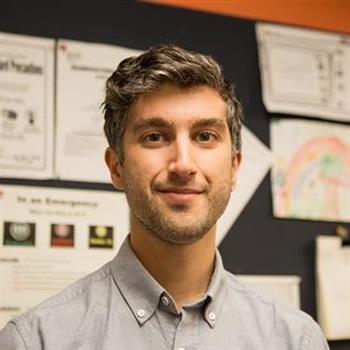“May you live in interesting times.”
Some call the ancient Chinese saying an expression of good wishes, while others describe it as a curse.

ADJUSTING TO THE MOMENT Alumnus Nicholas Stone says that while today’s youth rely on sources other than newspapers and network TV, they are well aware of politics, governance and issues that affect their lives and communities. (Photo: TC Archives)
For his part, Nick Stone (M.A. ’14) can think of no alternative to teaching government and economics other than “through the prism of contemporary issues.”
“The New York Times and Washington Post are basically my textbooks,” says Stone, a Social Studies teacher at Millennium High School in Lower Manhattan.
The New York Times and Washington Post are basically my textbooks.
This past summer, the Times returned the compliment, selecting Stone from hundreds of applicants as one of 60 educators for the 2020-21 New York Times Teaching Project cohort.
Stone had applied to be part of the project back before the COVID pandemic hit. “An opportunity to meet and work with like-minded educators from around the country seemed like a no-brainer,” he says.
Unfortunately, the Times had to cancel this summer’s in-person symposium on curriculum development, but the teachers and school librarians from 29 states instead used digital platforms to hold conversations on topics that included the pandemic, social justice, STEM teaching strategies and the Times’ 1619 Project on the 400-year legacy of legacy of slavery in America.
A self-described lifelong news consumer, Stone, who earned his TC degree in Social Studies Education, acknowledges that young people for the most part do not use the sources that sustained their parents and grandparents: newspapers, magazines and network news broadcasts. But he believes they are neither less interested in nor less aware of politics, governance and the matters shaping their communities and world.
“They get a lot of information from each other and social media,” Stone says. “By the time I get them, they are pretty good at seeking out reliable information and reading it critically. We build on that by making media literacy is a big part of our curriculum. We try to push hard into the middle ground of quote-unquote ‘reliable information’ and, as a result, it doesn’t take a lot for students to discern real news from fake news.”
Media literacy is a big part of our curriculum. We try to push hard into the middle ground of quote-unquote ‘reliable information.’
The project Stone proposed to the Times’ selection committee is titled “Contemporary Controversies.” As he conceives it, teachers will form small groups of students and task each group with analyzing and evaluating opinions expressed by a New York Times columnist on a controversial subject and then leading discussions by the full class on that topic.
“It will give them a sense of how a columnist develops opinions and beliefs,” says Stone, who will describe the project’s outcome in a capstone paper presented to his Teaching Project cohort next summer.
Of course, Stone can’t control how “Contemporary Controversies” work might unfold in other schools. But in a year marked by a global pandemic, a reckoning for social justice, climate change-induced wildfires, the death of a transformative U.S. Supreme Court Justice and a presidential election in a deeply divided nation, it’s a sure bet that students in his government and economics courses will have their work cut out for them.
Interesting times, indeed.

